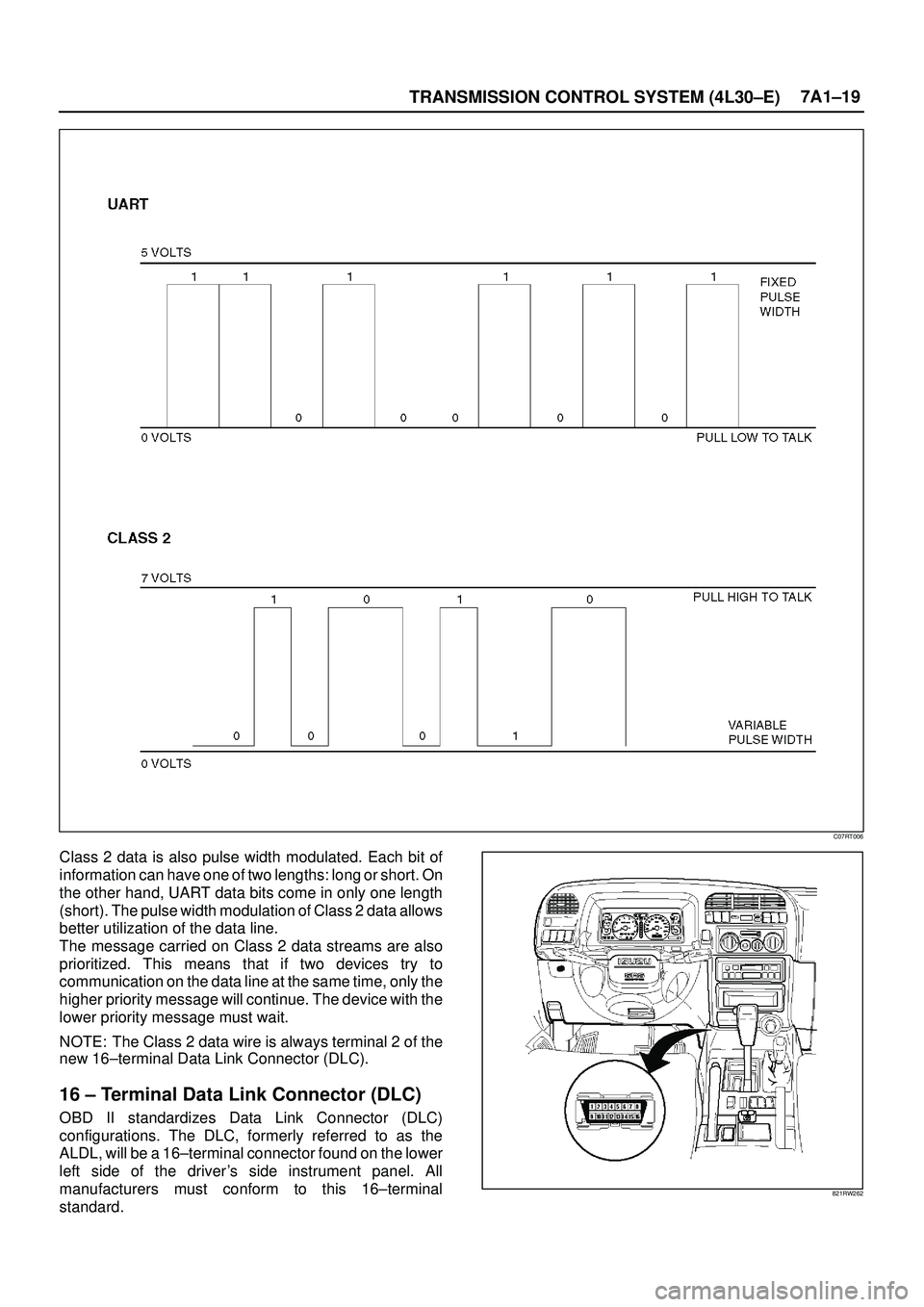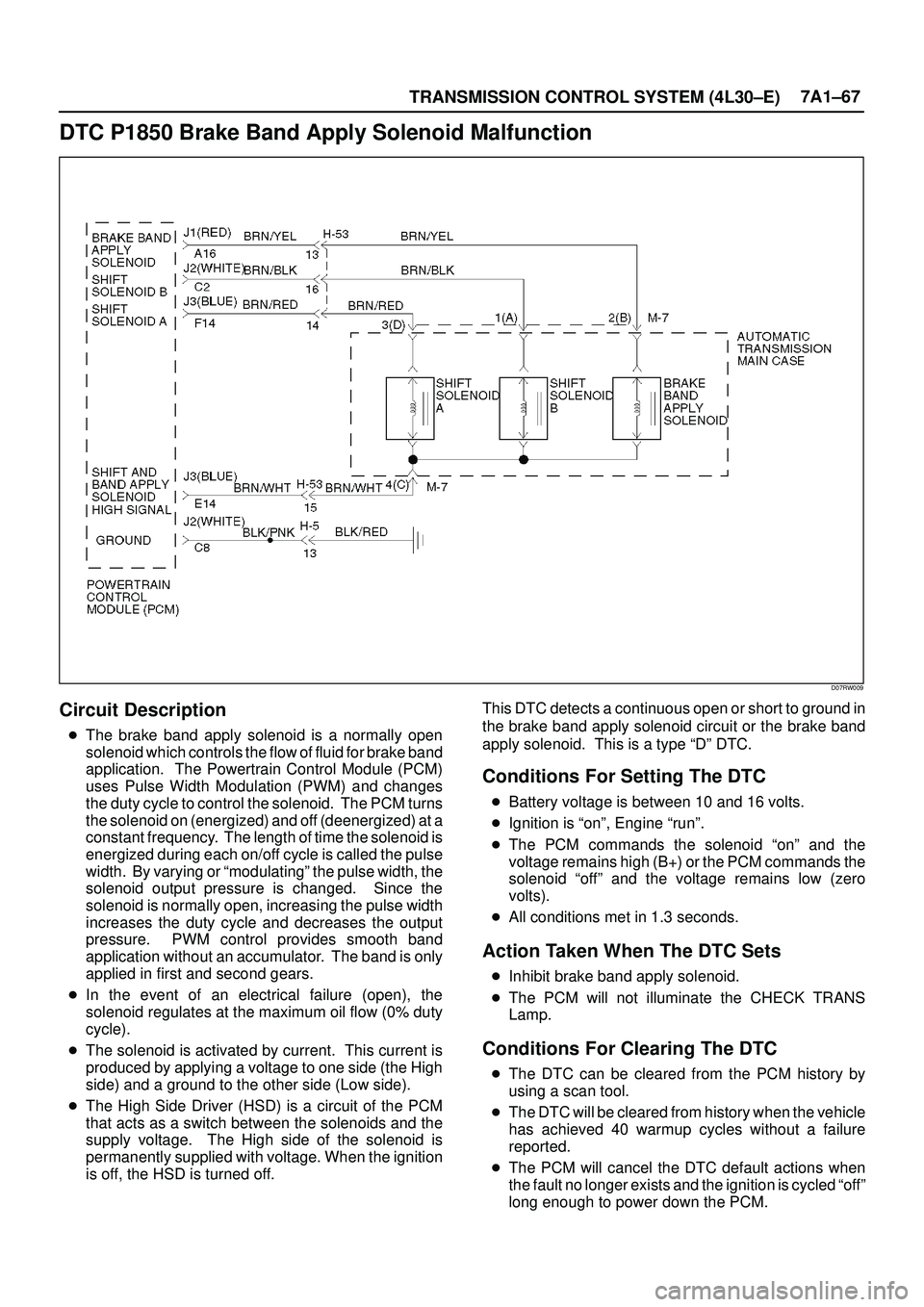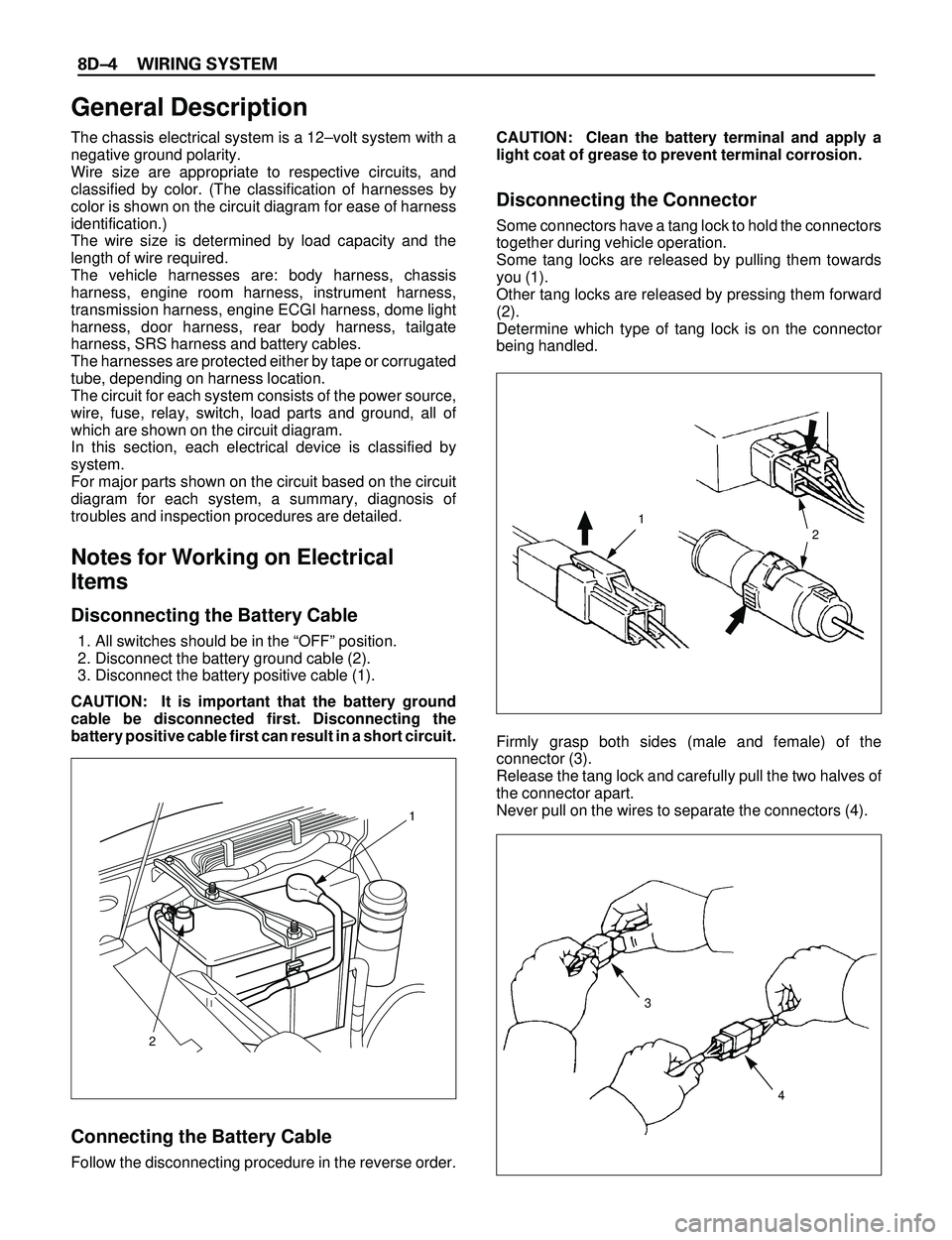Page 2264 of 3573

TRANSMISSION CONTROL SYSTEM (4L30±E)7A1±19
C07RT006
Class 2 data is also pulse width modulated. Each bit of
information can have one of two lengths: long or short. On
the other hand, UART data bits come in only one length
(short). The pulse width modulation of Class 2 data allows
better utilization of the data line.
The message carried on Class 2 data streams are also
prioritized. This means that if two devices try to
communication on the data line at the same time, only the
higher priority message will continue. The device with the
lower priority message must wait.
NOTE: The Class 2 data wire is always terminal 2 of the
new 16±terminal Data Link Connector (DLC).
16 ± Terminal Data Link Connector (DLC)
OBD II standardizes Data Link Connector (DLC)
configurations. The DLC, formerly referred to as the
ALDL, will be a 16±terminal connector found on the lower
left side of the driver's side instrument panel. All
manufacturers must conform to this 16±terminal
standard.
821RW262
Page 2312 of 3573

TRANSMISSION CONTROL SYSTEM (4L30±E)7A1±67
DTC P1850 Brake Band Apply Solenoid Malfunction
D07RW009
Circuit Description
�The brake band apply solenoid is a normally open
solenoid which controls the flow of fluid for brake band
application. The Powertrain Control Module (PCM)
uses Pulse Width Modulation (PWM) and changes
the duty cycle to control the solenoid. The PCM turns
the solenoid on (energized) and off (deenergized) at a
constant frequency. The length of time the solenoid is
energized during each on/off cycle is called the pulse
width. By varying or ªmodulatingº the pulse width, the
solenoid output pressure is changed. Since the
solenoid is normally open, increasing the pulse width
increases the duty cycle and decreases the output
pressure. PWM control provides smooth band
application without an accumulator. The band is only
applied in first and second gears.
�In the event of an electrical failure (open), the
solenoid regulates at the maximum oil flow (0% duty
cycle).
�The solenoid is activated by current. This current is
produced by applying a voltage to one side (the High
side) and a ground to the other side (Low side).
�The High Side Driver (HSD) is a circuit of the PCM
that acts as a switch between the solenoids and the
supply voltage. The High side of the solenoid is
permanently supplied with voltage. When the ignition
is off, the HSD is turned off.This DTC detects a continuous open or short to ground in
the brake band apply solenoid circuit or the brake band
apply solenoid. This is a type ªDº DTC.
Conditions For Setting The DTC
�Battery voltage is between 10 and 16 volts.
�Ignition is ªonº, Engine ªrunº.
�The PCM commands the solenoid ªonº and the
voltage remains high (B+) or the PCM commands the
solenoid ªoffº and the voltage remains low (zero
volts).
�All conditions met in 1.3 seconds.
Action Taken When The DTC Sets
�Inhibit brake band apply solenoid.
�The PCM will not illuminate the CHECK TRANS
Lamp.
Conditions For Clearing The DTC
�The DTC can be cleared from the PCM history by
using a scan tool.
�The DTC will be cleared from history when the vehicle
has achieved 40 warmup cycles without a failure
reported.
�The PCM will cancel the DTC default actions when
the fault no longer exists and the ignition is cycled ªoffº
long enough to power down the PCM.
Page 2532 of 3573
CLUTCH7C±23
Disassembly
(4JX1)
1. Remove damper cylinder assembly and gasket.
2. Remove push rod damper.
NOTE: T h e m a s t e r cylinder assembly cannot be
disassembled because of point±staked rod stopper.
Inspection and Repair
Clean and inspect the removed parts.
Make necessary parts replacement if any abnormalities
such as wear, oil leaks or other damage are found through
inspection.
Reassembly
To reassemble, follow the disassembly steps in the
reverse order, noting the following points:
1.Push rod set length
RHD: 117.5 mm (4.626 in)
LHD: 119 mm (4.685 in)
2.Push rod nut torque
17 N´m (1.7 kg´m/12 Ib ft)
3.Damper cylinder torque
47 N´m (4.8 kg´m/35 Ib ft)
Page 2580 of 3573
WIPER/WASHER SYSTEM8B–11
Rear Washer Spray Pattern
885RS003
Legend
(1) Washer Nozzle
(2) Spray Target
Rear Wiper Blade Rubber
Removal and Installation
Refer to the Windshield Wiper Blade Rubber in this
section.
Headlight Wiper/Washer
General Description
The circuit consists of the starter switch, headlight
wiper/washer switch, headlight wiper motor and washer
motor. By pushing the headlight wiper/washer switch with
the starter switch on, the wiper will make 5 strokes with
washer solution applied between each of the first 4
strokes, regardless of the length of time the switch is held
down.
The washer nozzle is installed to the wiper blade, and the
tank to which the washer motor is installed shared among
the headlight washer and the windshield washer.
Page 2597 of 3573

8DÐ4 WIRING SYSTEM
The chassis electrical system is a 12Ðvolt system with a
negative ground polarity.
Wire size are appropriate to respective circuits, and
classified by color. (The classification of harnesses by
color is shown on the circuit diagram for ease of harness
identification.)
The wire size is determined by load capacity and the
length of wire required.
The vehicle harnesses are: body harness, chassis
harness, engine room harness, instrument harness,
transmission harness, engine ECGI harness, dome light
harness, door harness, rear body harness, tailgate
harness, SRS harness and battery cables.
The harnesses are protected either by tape or corrugated
tube, depending on harness location.
The circuit for each system consists of the power source,
wire, fuse, relay, switch, load parts and ground, all of
which are shown on the circuit diagram.
In this section, each electrical device is classified by
system.
For major parts shown on the circuit based on the circuit
diagram for each system, a summary, diagnosis of
troubles and inspection procedures are detailed.
Notes for Working on Electrical
Items
Disconnecting the Battery Cable
1. All switches should be in the ÒOFFÓ position.
2. Disconnect the battery ground cable (2).
3. Disconnect the battery positive cable (1).
CAUTION: It is important that the battery ground
cable be disconnected first. Disconnecting the
battery positive cable first can result in a short circuit.
Connecting the Battery Cable
Follow the disconnecting procedure in the reverse order.CAUTION: Clean the battery terminal and apply a
light coat of grease to prevent terminal corrosion.
Disconnecting the Connector
Some connectors have a tang lock to hold the connectors
together during vehicle operation.
Some tang locks are released by pulling them towards
you (1).
Other tang locks are released by pressing them forward
(2).
Determine which type of tang lock is on the connector
being handled.
Firmly grasp both sides (male and female) of the
connector (3).
Release the tang lock and carefully pull the two halves of
the connector apart.
Never pull on the wires to separate the connectors (4).
2
1
General Description
1
2
3
4
Page 2601 of 3573

8DÐ8 WIRING SYSTEM
5. The wiring harness between engine and chassis
should be long enough (2). Tension of the wire (1) may
causes chafing or damage due to various vibrations.
Splicing Wire
1. If the harness is taped, remove the tape. To avoid wire
insulation damage, use a sewing Òseam ripperÓ
(available from sewing supply stores) to cut open the
harness.
If the harness has a black plastic conduit, simply pull
out the desired wire.
2. Begin by cutting as little wire off the harness as
possible. You may need the extra length of wire later
if you decide to cut more wire off to change the location
of a splice. You may have to adjust splice locations to
make certain that each splice is at least 1Ð1/2Ó
(40 mm) away from other splices, harness branches,
or connectors.
3. When replacing a wire, use a wire of the same size as
the original wire.
Check the stripped wire for nicks or cut stands. If the
wire is damaged, repeat the procedure on a new
section of wire. The two stripped wire ends should be
equal in length.
4. Select the proper clip to secure the splice.
To determine the proper clip size for the wire being
spliced, follow the directions included with your clips.
Select the correct anvil on the crimper. (On most
crimpers your choice is limited to either a small or
large anvil.)
Overlap the two stripped wire ends and hold them
between your thumb and forefinger as shown in the
figure.
The center the spline clip (1) under the stripped wires
and hold it in place.cOpen the crimping tool to its full width and rest one
handle on a firm flat surface.
cCenter the back of the splice clip on the proper anvil
and close the crimping tool to the point where the back
of the splice clip touches the wings of the clip.
cMake sure that the clip and wires are still in the correct
position. Then, apply steady pressure until the
crimping tool closes as shown in the figure.
2
11
Page 2606 of 3573
WIRING SYSTEM 8DÐ13
Wiring Ð Wire Size
The size of wire used in a circuit is determined by the
amount of current (amperage), the length of the circuit,
and the voltage drop allowed. The following wire size and
load capacity, shown below, are specified by AWG
(American Wire Gauge). (Nominal size means
approximate cross sectional area (1).)
Wiring Ð Wire Size Table
Nominal sizeCross sectional Outside diameter Allowable
area (mm2) (mm) current (A)
0.3 0.372 1.5 9
0.5 0.563 1.7 12
0.85 0.885 1.9 16
1.25 1.287 2.2 21
2 2.091 2.7 28
3 3.296 3.6 37.5
5 5.227 4.4 53
8 7.952 5.5 67
15 13.36 7.0 75
20 20.61 8.2 97
1
Page 2922 of 3573
WIRING SYSTEM 8D – 329
Headlight Wiper/Washer
General Description
The circuit consists of the starter switch, headlight
wiper switch, headlight wiper motor and washer
motor. By pushing the headlight wiper/washer switch
with the starter switch on, the wiper will make 5
strokes with washer solution applied between each
of the first 4 strokes, regardless of the length of time
the switch is held down.
The washer nozzle is installed to the wiper blade, and
the tank to which the washer motor is installed shared
between the headlight washer and the windshield
washer.